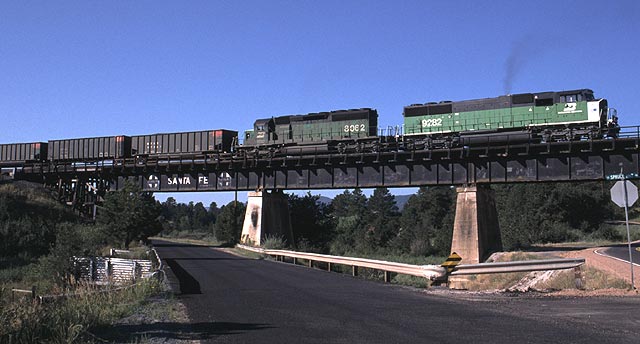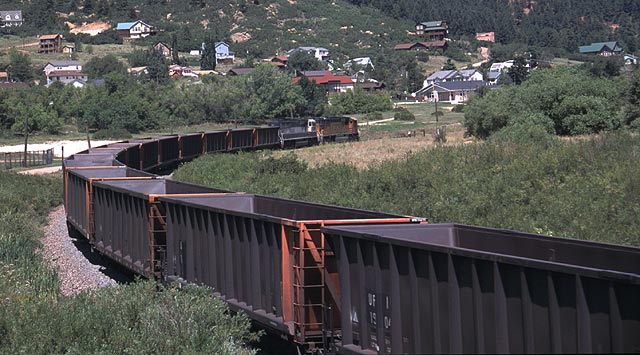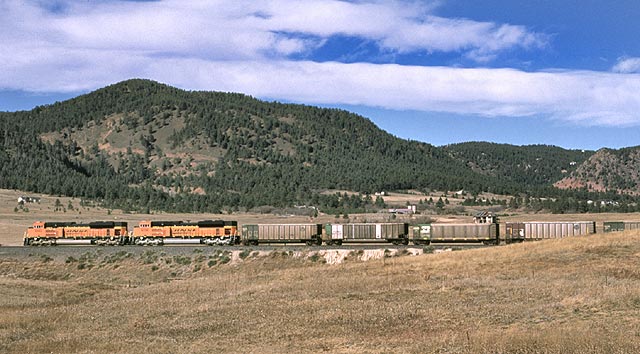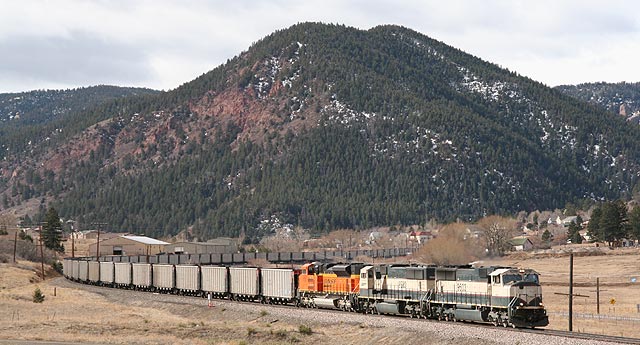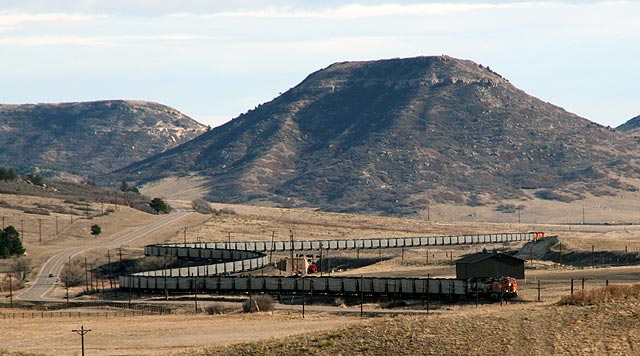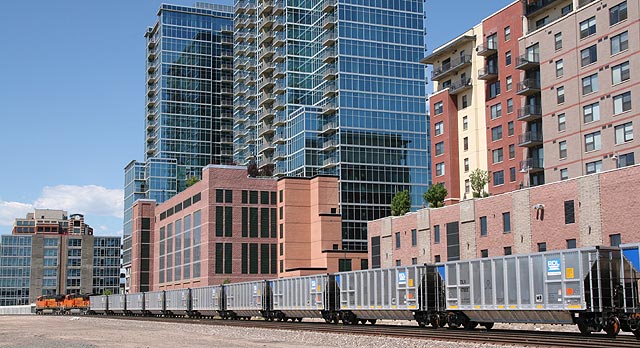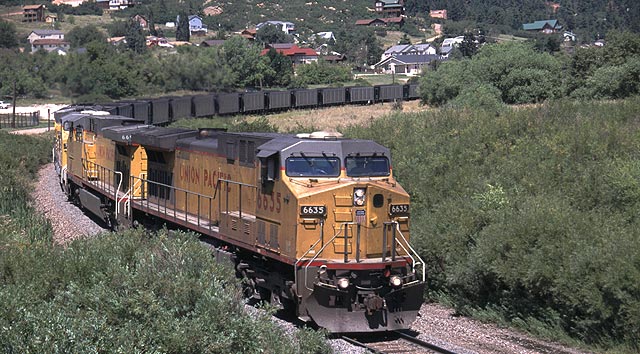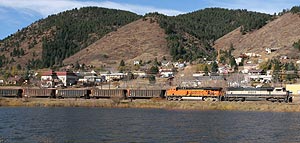
I recognize that my coal car data table is quite long and overwhelming to look at so I decided to create a summary of the common Joint Line coal trains as an aid for railfans and modelers who want to know what trains go where. This essay will summarize the typical coal trains found on both the BNSF and UP on the Joint Line from 2000-present. I've organized it by owner/operator with typical reporting marks noted.
Arizona Electric Power coal trains (AZEX/AZPX)
The Arizona Electric Power trains are part of the handful of UP coal trains traveling on the Joint Line. They are few and far-between, with only a few trainsets making the long trip between western Colorado mines and southern Arizona power plants via a route that takes the trains into Texas and New Mexico. Aluminum rotary-dump hoppers are the typical consists, with some MBKX lease cars also used.
BNSF coal trains (BNSF, BN)
Although these freight car details are not covered in my data table, there are a lot of BNSF coal cars operating on the Joint Line. These consist mainly of the various BNSF Bethgons and Bethgon clones (i.e. Trinityrail 4402s). Many of the older BN aluminum coal gondolas from the 1990s are still operating, although no longer in matched sets. New coal cars run in matched sets for a few years, then they start getting mixed up as individual cars are taken out of service for maintenance or totalled-out in wrecks. The end result is most of the coal trains with BNSF equipment end up being a hodge podge collection of BNSF/BN cars with various leasers mixed in (CEFX, CITX, FURX, NCUX, etc). Although I don't know all of the BNSF coal train destinations, I do know that some trains go to Texas Municipal Power (Gibbons Creek, TX) and some go to Springerville Station (Springerville, AZ).
Celanese coal trains (TILX, UP, CNW, CHTT)
The Celanese trains are Joint Line classics. They've operated using many different cars over the years - beginning with ATSF hoppers in the 1980s, then UP hoppers in the 1990s-2000s, and last with TILX leased hoppers (mid-2000s to 2008). These trains originate at Colorado mines served by the UP and are destined for a cogeneration plant at the Hoechst-Celanese plant in Kings Mill, Texas (served by the ATSF and later BNSF). During the 2000s, the trains used UP motive power with a mix of UP/CNW/CHTT coal hoppers and later TILX aluminum-bodied dual-purpose rotary hoppers. The Celanese plant was shut down in 2008 which ended these trains.
Colorado Springs Utilities coal trains (CSUX)
A handful of UP-powered CSUX trains serve the two coal-fired Colorado Springs power plants (Nixon and Drake). The old Ortner rapid-discharge hoppers (with the CSDU lightning bolt paint schemes) were replaced in 2001 with plain aluminum hoppers.
Entergy coal trains (EGSX, ETRX)
A couple of Louisiana-bound Entergy trains operate on the BNSF Joint Line. These trains typically consist of aluminum rotary gondolas, sometimes with BNBX leasers. Prior to the "aluminum era" railcars, these trains operated with GSNX steel gondolas.
Fayette Power Project coal trains (FPPX, LCRX)
The Fayette Power Project trains are also Joint Line classics. In the 1980s, they were known for operating dark green coal cars with matching MKT run-through motive power. For the most of the 2000s, the dark green steel rotary gondolas still operated but now behind BNSF motive power. In 2009 all the green steel trainsets were replaced with aluminum-bodied rotary gondolas with yellow ends. These trains serve the Fayette Power Project, which is a large coal-fired power plant in central Texas.
NRG coal trains (PNJX, TGNX) - formerly Texas GenCo...Reliant Energy...Houston Lighting & Power/Utility Fuels (UFIX)
The NRG trains serve NRG-owned power plants in Texas, with most going to W.A. Parish (BNSF destination "Smithers Lake") near Houston. The NRG railcars come in two basic flavors: orange ends and blue ends. The orange end cars are most common and have TGNX marks (assigned for Texas GenCo - the predecessor to NRG-Texas). The blue end cars are marked either PNJX or MQRX and are owned by GE Railcar Services or Macquarie Rail respectively. These are under long term lease to NRG. The NRG railcars are noteworthy as they are some of the rare coal cars to actually have logos on the sides. Many cars are also marked with employee names (and their respective power plants). The employee names used are those with long-term seniority in coal handling at NRG's power plants.
In addition to the TGNX/PNJX cars, leasers from CEFX, PSTX, and TILX are commonly seen as well on NRG trains.
For those who don't know, the NRG cars replaced all the UFIX trainsets during 2006-2007. The UFIX trains were pretty much ubiquitous Joint Line trains from the 1980s into the 2000s. There is a long chain of mergers and acquisitions that led Utility Fuels into NRG and it goes something like this: Utility Fuels was a subsidiary of Houston Industries, who also owned Houston Lighting and Power. Through mergers and acquisitions, HL&P and Utility Fuels ended up under control of Reliant Energy in the 1990s. This later became Texas GenCo and then part of NRG in the 2000s.
TUCO coal trains (AMTX, GRTX, KLLX, TLKX, TILX)
The TUCO trains serve two Southwest Public Service plants in northwest Texas: Harrington and Tolk. The cars used are marked AMTX, GRTX, KLLX, TLKX, and TILX. The AMTX/GRTX/KLLX cars are dual-purpose rotary hoppers. The TLKX cars are rotary gondolas. The TILX leasers consist of conventional dual-purpose rotary hoppers as well as new RDL (longitudinal-dump) rotary hoppers. In the past, these trains were mostly RTPX and SDEX steel-bodied cars operated by Savage, but they were phased out between 2003 and 2006. The GRTX cars were eliminated in 2008.
TXU coal trains (TXUX)
TXU trains are common on the BNSF Joint Line. These trains consist of aluminum hoppers and served several TXU power plants in Texas. In 2008, TXU changed its named to Luminant. At the same time they took delivery of several hundred new aluminum hopper cars.
UP coal trains (UP, CHTT, CNW, CTRN, DRGW)
Union Pacific operates a small handful of coal trains on the Joint Line with UP coal cars. Most of these are going to a power plant in Salida (west of Pueblo). Early in the decade, other UP trains were going to Celanese in Texas.
Western Farmers Co-Op coal trains (WFCX)
In the early 2000s, WFCX trains were commonly seen on the BNSF Joint Line serving Western Farmers Co-Op's coal-fired power plant in Fort Towson, Oklahoma. These trains used steel-bodied rotary gondolas. Around 2006 the trains were re-routed out-of-state, heading east out of the PRB across Nebraska instead of south through Colorado. The steel cars were later replaced with aluminum rotary gondolas.
Western Fuels Association coal trains (WFAX)
The WFAX trains are another historical staple on the Joint Line. For most of the 2000s, the majority of WFAX trains on the Joint Line were operating to Sunflower Electric Power in Holcomb, Kansas, via the BNSF. In the early part of the decade, black steel-bodied rotary gondolas were used. These were phased out in 2006 and replaced with new aluminum rotary gondolas. There is also a train of dual-purpose aluminum rotary hoppers in WFAX service as well.
Beginning in 2008, another WFAX train appeared on the BNSF serving Arkansas River Power Authority in Lamar, Colorado.
Xcel Energy coal trains (XCLX; formerly PSCX)
Xcel (XCLX) coal trains spotted on the Joint Line are typically heading for Comanche Station in Pueblo. A few trains will occasionally serve Arapahoe Station in Denver, although they don't spend more than a few miles on the Joint Line so it's hard to call them Joint Line coal trains. Xcel's fleet currently consists mainly of dual-purpose rotary hoppers built in 2006. The old Public Service (PSCX) coal cars were replaced with aluminum XCLX cars during 2006-2007. Ex-NSPX rotary hoppers are now common as well alongside the new-built XCLX cars.
Other miscellaneous Joint Line coal trains
The trains mentioned above were commonly seen on the Joint Line from 2000-present (although a few have disappeared). This is by no means a complete list of every coal train to ever operate on the Joint Line in this decade. It is not uncommon for BNSF to re-route other coal trains occasionally across the Joint Line to avoid congestion or maintenance on other rail corridors. A good example of this is the Georgia Power trains (RWSX/HBWX/HYWX), which will occasionally run on the Joint Line in waves lasting up to a couple weeks...then they disappear for months (or years). Trains for AEP (AEPX), Westar (KPLX), Empire District Electric (EDEX), Oklahoma Gas & Electric (OGEX), and Exelon (EXEX/KGLX) will also occasionally be routed over the Joint Line.
